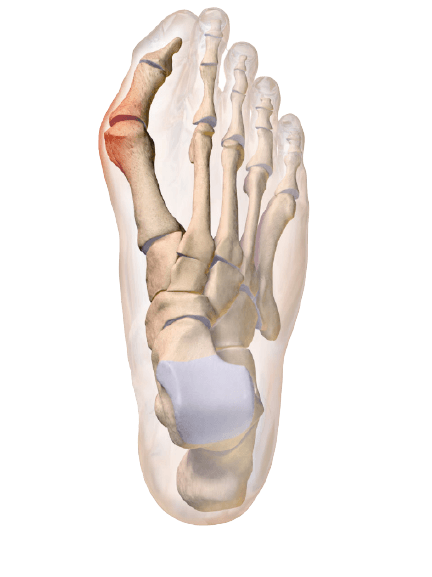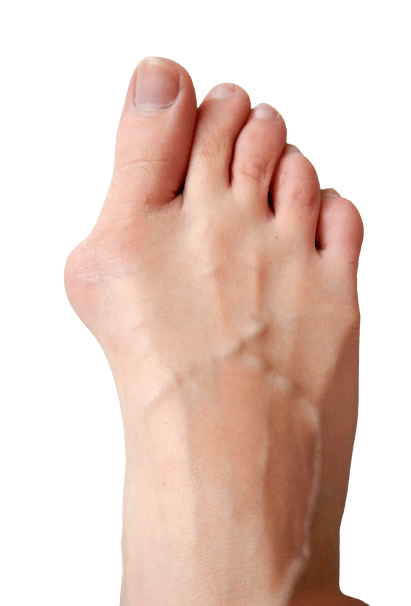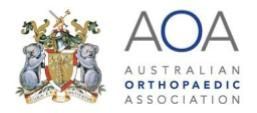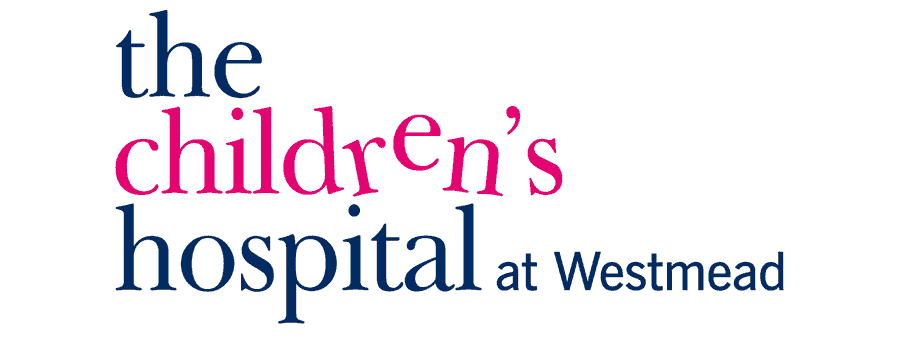Bunion (Hallux Valgus)
What are Bunions and Bunionettes?
Bunions and bunionettes also known as Hallux Valgus are a bony protuberance and is a medical disorder of the foot and one of the most common reasons for painful toes.
A misalignment of the bones in the feet results in the 1st metatarsal bone abnormally angling outwards resulting in a bony bump on the base of the big toe - this is known as a bunion, and if it occurs on the base of the little toe - a bunionette.
These conditions can become extremely painful over a long period of time.
Who Do Bunions and Bunionettes Affect?
Bunions are more common than bunionettes. They can affect anybody wearing improper shoes and those having an inherited structural deficiency. Women are typically most affected, but men too can suffer from bunions.
They are more commonly found in elderly people over the age of 60.
How Do Bunions and Bunionettes Occur?
Bunions most commonly occur due to external pressure that forces the big toe to fold over the smaller toes, turning inward. This results in the joint becoming larger and projecting outwards, resulting in the bunion formation.
Bunionettes are also known as ‘tailor’s bunion’ since they occur most commonly in tailors sitting cross-legged for long durations, with the little toes being rubbed against the ground.
Causes Of Bunions and Bunionettes?
Although it is not clearly understood why bunions occur, possible causes include:
- Family history and genetics
- Arthritis (inflammation of the joints) including rheumatoid arthritis, psoriatic arthritis and gout
- Neuromuscular conditions such as cerebral palsy (affects movement and coordination)
- Connective tissue disorders such as Marfan’s syndrome (affects the connective tissues)
- Tight fitting shoes that are too tight, narrow or high heeled.
Bunions are common in women and tend to run in families.
Symptoms of Bunions and Bunionettes
The symptoms include:
- Bony projection jutting outwards at the base of the joint of either the big toe or the little toe
- Tenderness and pain on touching or wearing shoes that are too tight
- Inflammation or redness around the affected joint
- Swelling
- Pain and tenderness around the big toe
- Turning of big toe towards the adjacent toe
- Change in the shape of the foot
- A bony mass at the joint surface of the big toe
- Pain and discomfort while walking
- Restricted movements of the big toe
Stages Of Bunions and Bunionettes
With time and continued use of narrow uncomfortable shoes, both bunions and bunionettes can become increasingly painful over time.
As the condition gets worse, it becomes more painful as the bump grows bigger in size. The big toe bends towards the next toe, changing the normal structure of the toes. A bump forms at the side of the big toe, making it difficult to walk or wear shoes.
How are Bunions and Bunionettes Diagnosed?
Your orthopaedic surgeon diagnoses a bunion based on the following:
- Medical history to inquire about pain, swelling, shoewear problems and progression of deformity
- Physical examination to evaluate the nature of the bunion
- Foot X-ray, CT or MRI to determine bone and soft tissue damage
How are Bunions and Bunionettes Treated?
Bunions and bunionettes once formed, are usually permanent unless surgically treated.
Non Surgical Treatments for Bunions
Some non-surgical options that can be recommended for pain relief include:
- Pain medications such as paracetamol or ibuprofen
- Wearing broad-toed shoes that fit properly to reduce the compression of the toes
- Using ice packs to reduce pain and swelling and getting adequate rest
- Using bunion pads, cushions and splints to protect and alleviate painful foot bunions
- Steroid injections to alleviate pain and swelling
In case the conservative approach still doesn’t result in pain relief, the doctor may recommend surgical options
Surgery for Bunions
Surgery aims to remove part of the bony projection or swollen tissue from the joint or fusing the bones of the affected joint to a better position permanently. Surgery can include:
- Soft Tissue Release: To release tight ligaments contributing to the deformity
- Osteotomy: To correct the bony alignment (including Akin Osteotomy, Chevron Osteotomy and Scarf Osteotomy)
The main purpose of surgery is to reduce pain, increase function and improve your quality of life.
What If Bunions and Bunionettes are Untreated?
A bunion can change the shape of your foot, make it difficult for you to find shoes that fit correctly.
If left untreated, bunions and bunionettes can become increasingly painful over time. Complication can include:
- Bursitis / Inflammation: Redness and pain at the site of the bunion
- Hammer toe formation: The lesser toes may become deformed and angulated
- Metatarsalgia: Altered weight bearing causes tenderness and swelling in the ball of the foot
- Progressive deformity:
The shape of the toes may continue to worsen









